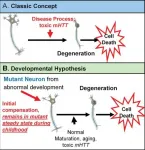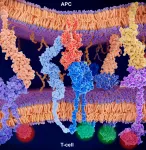(Press-News.org) Amsterdam, NL, January 6, 2021 - There is growing evidence to support the hypothesis that there is a neurodevelopmental component to the late-onset neurodegeneration occurring in the brain of huntingtin gene (HTT gene) mutation carriers, and that this increased susceptibility to brain cell death begins during childhood. Experts discuss the evidence that the HTT gene mutation affects brain and body growth based on a unique study of children at risk for HD, the Kids-HD study, in a review paper and accompanying research article published in the Journal of Huntington's Disease.
The classic concept is that Huntington's disease is caused by toxic mutant huntingtin (mHTT) acting over time on mature brain cells. However, there is growing evidence for an alternative theory in which mHTT has an effect on brain development and that this altered development plays a vital role in the later degenerative process. This theory is based on the notion that wild-type huntingtin (HTT) function plays a role in normal brain development.
"Although the gene was discovered in 1993, we still don't have a good understanding of what causes HD - how does the mutant gene cause brain cells to become 'sick' then die?" noted lead investigator Peg C. Nopoulos, MD, Department of Psychiatry, Department of Pediatrics, and Department of Neurology, University of Iowa Carver College of Medicine, Iowa City, IA, USA. "The neurodevelopmental hypothesis is a relatively new way of thinking about the disease and can help focus research efforts in a new direction. This review and the accompanying study are important in reshaping our ideas about how we view the nature and timing of preventive treatment for HD and the factors that contribute to disease."
The neurodevelopmental hypothesis of HD posits that the disease-causing gene mutation affects development of a specific region or specific brain circuit. These cells are abnormal in their growth; however, they are compensated for early in life. Therefore, despite abnormal development, there are no overt symptoms. The abnormally developed cells remain in a "mutant steady state." These cells are then vulnerable to dysfunction and degeneration later in life when they are subjected to stresses and strains, either normal (programmed synaptic elimination during puberty or through the aging process) or pathological (toxic effects of mHTT). In the end, the disease pathology results in neural degeneration with its accompanying cognitive and motor deficits.
The two papers focus on the most recent findings from Kids-HD, a unique brain imaging study of children aged six to 18 years old at risk for HD because they have a parent or grandparent with HD. The review discusses the effects of mHTT on brain development and the study evaluates the effect of mHTT on body development.
According to the authors, there is evidence in children as young as 6 who carry a mutation in the HTT gene, that production of mHTT alters the growth and development of the striatum and related circuitry. The gene contains a sequence of three DNA bases - cytosine-adenine-guanine (CAG) - repeated multiple times. The developmental changes appear to be influenced by the CAG repeat length and occur well before onset of symptoms of the disease. Deficits may then be compensated for by increased activity in other brain circuits, particularly those involving the cerebellum, and are manifest only when compensatory systems are no longer working.
The body development analysis used data from the 186 children in the Kids-HD study. Investigators applied simple measures of growth - height, weight, and the combined BMI measure - to compare changes in two groups - those who carried the CAG repeat expansion mutation in the HTT gene and those who did not.
Around puberty the study began to show an altered trajectory of growth in HTT gene mutation carriers. The pace at which their BMI increased slowed over time so that at by about 17 years old, that group had substantially lower BMI than the group without the gene mutation. Boys with the gene mutation tended to be taller than the control group, but with lower weight; girls with the gene mutation tended to be around the same height, but lower in weight.
Importantly, although the gene mutation carriers were roughly 30 years from the expected time of onset of the disease, the mutant HTT gene had already affected their growth and development. This work is important because it suggests that the mutation is altering the body even before the onset of neurological disease in midlife.
Gene therapy trials are currently underway to evaluate the effectiveness of drugs to slow disease progression in affected individuals, and future trials will ultimately aim to prevent disease onset by delivery of gene therapy to gene mutation carriers - those with mHTT, but no symptoms.
"Gene therapy trials are finally here. However, interfering with a gene responsible for brain development early in life must be done with an abundance of caution," commented Dr. Nopoulos. "Understanding how mHTT affects brain development is vital in the context of planning disease prevention therapies."
HD is a fatal genetic neurodegenerative disease that causes the progressive breakdown of nerve cells in the brain. An estimated 250,000 people in the United States are either diagnosed with, or at risk for, the disease. Symptoms include personality changes, mood swings and depression, forgetfulness and impaired judgment, unsteady gait, and involuntary movements (chorea). Every child of an HD parent has a 50% chance of inheriting the gene. Patients usually survive 10 - 20 years after diagnosis.
INFORMATION:
Engineers at the University of Maryland (UMD) have created a new shape-changing or "morphing" 3D printing nozzle that was featured as a Frontispiece in the January 5th issue of the journal Advanced Materials Technologies.
The team's morphing nozzle offers researchers new means for 3D printing "fiber-filled composites" - materials made up of short fibers that boost special properties over traditional 3D-printed parts, such as enhancing part strength or electrical conductivity. The challenge is that these properties are based on the directions or "orientations" of the short fibers, which has been difficult to control during the 3D printing process, until now.
"When 3D printing with the morphing nozzle, the power lies on ...
A survey of approximately 5,000 Americans suggests that 31.1 percent of the U.S. public does not intend to get the COVID-19 vaccine once it becomes available to them - and the likelihood of vaccine refusal is highest among Black Americans, women and conservatives.
Timothy Callaghan, assistant professor at the Texas A&M University School of Public Health, led the study with the aim of better understanding the intentions of the American public regarding vaccines. The results were recently published in Social Science and Medicine.
According to the study, survey respondents answered a series of questions about their behaviors and attitudes about COVID-19, including why or why not they intend to pursue vaccination. Women are 71 percent ...
In a paper published by the journal Matter, engineers from the University of Surrey together with partners from Harvard University, University of Science and Technology of China, UK National Physical Laboratory, George Washington University and Zhejiang University Ningbo Research Institute report on how they have developed a breakthrough sensor system and manufacturing process.
The global team of engineers reveal that the new contact lens sensor system contains a photodetector for receiving optical information, a temperature sensor for diagnosing potential corneal disease and a glucose sensor ...
Musical masterworks as the Queen of the Night's Aria from Mozart's The Magic Flute, are examples of the sounds trained human voices can produce. The precondition for vocal virtuosity as well as for any spoken word is vocal learning, the ability to imitate auditory input. Some songbirds and bats can do this, but humans excel. We can acquire new languages into old age. To shed light on the evolution of vocal learning, a team led by Julia Fischer from the German Primate Center (DPZ) - Leibniz Institute for Primate Research has analyzed the sound structures of Guinea baboons and was ...
CLEVELAND - In a new paper, researchers describe their development of a near-real time spatial assessment of COVID-19 cases to help guide local medical responses to clusters of outbreaks of the virus at the local level.
The paper, entitled "Geographic monitoring for early disease detection (GeoMEDD)," appeared in the Dec. 10 issue of Nature Scientific Reports and comes from researchers at Case Western Reserve University (CWRU) School of Medicine, University Hospitals (UH) Cleveland Medical Center, and Texas A & M University.
While developing a tracking system during the beginning stages of the COVID-19 pandemic, ...
A first-of-its-kind study conducted under the bed of the Dead Sea reveals that a devastating earthquake measuring 6.5 on the Richter scale is expected to hit our region in the coming years. The study showed that an earthquake of this magnitude occurs in the land of Israel on an average cycle of between 130 and 150 years, but there have been cases in history where the lull between one earthquake and another was only a few decades long.
The last earthquake with a magnitude of 6.5 on the Richter scale was felt in the Dead Sea valley in 1927, when hundreds of people were injured in Amman, Jerusalem, Bethlehem and even Jaffa. Now, in the wake of the findings ...
A microbe found in the colon and commonly associated with the development of colitis and colon cancer also may play a role in the development of some breast cancers, according to new research from investigators with the Johns Hopkins Kimmel Cancer Center and its Bloomberg~Kimmel Institute for Cancer Immunotherapy. Breast tissue cells exposed to this toxin retain a long-term memory, increasing the risk for disease.
In a series of laboratory experiments, researchers discovered that when enterotoxigenic Bacteroides fragilis (ETBF) was introduced to the guts or breast ducts of mice, it always induced growth and metastatic progression of tumor cells. A description of the work is published in the January 6 issue of the journal Cancer Discovery.
While microbes are known to be present in ...
DALLAS - Jan. 6, 2020 - UT Southwestern scientists have developed a new method to study the molecular characteristics of T cells, critical immune cells that recognize and attack invaders in the body such as viruses, bacteria, and cancer.
The approach, described today in the journal Nature Methods, enables researchers to more easily analyze the roles of T cell receptors (TCRs) - the molecules on the surfaces of T cells that are responsible for recognizing pathogens.
"This could lead to a better understanding of how T cells work as well as new ways to harness T cells to fight disease," ...
Philadelphia, January 6, 2021 - A multidisciplinary team of researchers led by Children's Hospital of Philadelphia (CHOP) has discovered several genetic markers associated with bone mineral accrual, which could ultimately help identify causes of eventual osteoporosis earlier in life through genetic testing. The findings, which were made possible by following a group of children over several years, were published online by the journal Genome Biology.
Osteoporosis is widely considered a disease of old age. However, the accrual of bone density early in life is critical for achieving optimal bone mass in adulthood ...
Using a blood test, a German-Dutch research team has predicted the risk of Alzheimer's disease in people who were clinically diagnosed as not having Alzheimer's disease but who perceived themselves as cognitively impaired (Subjective Cognitive Declined, SCD). The researchers analyzed blood samples from an SCD cohort supervised at the Alzheimer Center Amsterdam. Using a test developed at Ruhr-Universität Bochum (RUB) called the Immuno-Infrared Sensor, they identified all 22 subjects at study entry who developed Alzheimer's dementia, thus the clinical symptoms, within six years. The test ...





